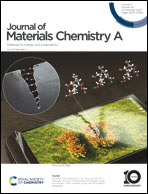Atomistic structural engineering of conjugated organic polymer cathodes for high-performance Li-organic batteries†
Abstract
Conjugated organic polymers have been deemed as one type of the most promising electrode materials for lithium-ion batteries (LIBs) due to their structural diversity and functional designability. However, the poor conductivities and limited redox-active sites of these polymers severely impede their applications in LIBs. Herein, four novel pyrene-4,5,9,10-tetraone (PTO)-based polymers (namely PTO-Bz, PTO-Py, PTO-Pm, and PTO-Tz) were designed and synthesized as cathode materials with high electrochemical activity (four redox sites of PTO units) and superb structural/chemical stability. By changing the N content in aryl linkers, the electronic conduction and transportation of polymer structures could be readily adjusted, leading to enhanced electrochemical activity. As a result, the optimal PTO-Py polymer displays high electronic conductivity and enhanced pseudocapacitive behavior compared with the other samples. When evaluated as a cathode for LIBs, the PTO-Py electrode shows a high lithium storage performance of 220.4 mA h g−1 with an ICE of 97.0% at 0.1 A g−1, superior rate performance (153.1 mA h g−1 at 10 A g−1), and excellent cycling abilities (70.8% capacity retention over 2000 cycles at 1.0 A g−1). In addition, ex situ FT-IR and XPS analyses were also carried out to further understand the Li+ storage mechanism. This work unveils an efficacious strategy to exploit high-performance conjugated organic polymer electrodes for energy storage systems.



 Please wait while we load your content...
Please wait while we load your content...